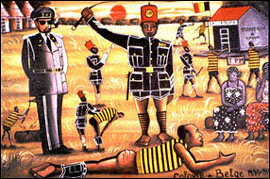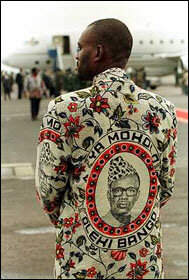 HISTORY HISTORY |
 "A Country Still Bearing The Imprint Of Its Colonial Past" "A Country Still Bearing The Imprint Of Its Colonial Past"
The area known as the Democratic Republic of the Congo (DRC) was inhabited by ancient groups of hunters and gatherers (Pygmies), as early as 10,000 years ago. They were settled in the 7th and 8th centuries A.D. by Bantu tribes from present day Nigeria. By the 14th century the first kingdoms appeared. One of them was the Kingdom of Kongo, which controlled a large part of the coastal area around the mouth of the Congo River. Further south, the most important kingdoms were the Luba, Kuba and Lunda.
This territory was discovered in 1482 by the portuguese navigator Diogo Cão. By the 17th century the portuguese, in their efforts to procure sufficient numbers of slaves for their brazilian plantations, began to undermine the economy of the Kongo and war errupted in 1660. The Kongo was then resoundingly beaten by the superior fire power of the portuguese (who called the country Zaire) and the Kingdom went into rapid decline.

Despite centuries of trade with european powers, there was no direct penetration of the interior until the 19th century. The American correspondent Henry M. Stanley navigated the Congo River in 1877 and opened the interior to exploration, commissioned by King Leopold. The area was officially colonized in 1885 as a personal possession of Belgian King Leopold II as the Congo Free State. King Leopold accumulated a vast personal fortune from ivory and rubber through Congolese slave labor. 10 million people are estimated to have died from forced labor, starvation, and outright extermination during Leopold's colonial rule. In 1907, administration shifted to the Belgian Government, which renamed the country the Belgian Congo.
In 1925, under a League of Nations mandate, the territories of Rwanda and Urundi (now Burundi) were incorporated administratively into the Belgian Congo. Following a series of riots and unrest, the Belgian Congo was granted its independence on June 30, 1960. Parliamentary elections in 1960 produced Patrice Lumumba as prime minister and Joseph Kasavubu as president of the renamed Democratic Republic of the Congo.
However, (under the pressure of factional and tribal disputes, the army mutiny and the governor of Katanga's attempt of secession, backed by superpower interests which worried about the allegedly pro-Western or pro-Soviet inclinations of the main contenders) this government fell within six months. Prime Minister Lumumba died under mysterious circumstances; and Colonel Joseph Mobutu (later Mobutu Sese Seko), who emerged as the main Western-backed military candidate able to guarantee stability in the country, took over the government and ceded it again to President Kasavubu.

This government lasted for four years before Mobutu, by now the army Chief of Staff, took control and declared himself president for 5 years. Mobutu quickly centralized power into his own hands and was elected unopposed as president in 1970. Embarking on a campaign of cultural awareness, Mobutu renamed the country the Republic of Zaire and required citizens to adopt African names. The regime, under its self-styled philosophy of 'Mobutuisme', was remarkable for the blatant nepotism and gargantuan larceny in which Mobutu, his family and principal supporters engaged; one of the more destructive dictatorship of Africa.
| Relative peace and stability prevailed until 1977 when Katangan rebels, staged in Angola, launched a series of invasions into the Katanga region. This rebels were driven out with the help of Belgian paratroopers. By then, Mobutu had become an embarrasment to his western backers (mainly France, Belguim and the USA). The economy went from bad to worse: corruption was wide-spread, the price for copper and cobalt (two main exportations of the country) was low, the external debt rose to staggering levels and the inflation rate was spiralling. Soon, industrial production was stagnant, food was in short supply and international aid to Zaire was suspended.
The campaign which brought about Mobutu's demise began in the remote north-eastern part of the country: it was spearheaded by the Rwandan military whose main objective was the destruction of Hutu rebel bases. By 1996, tensions from the neighboring Rwanda war had spilled over to Zaire. Rwandan Hutu militia forces (Interahamwe), who had fled Rwanda following the ascension of a Tutsi-led government, had been using Hutu refugee camps in eastern Zaire as a basis for incursion against Rwanda. These Hutu militia forces soon allied with the Zairian armed forces (FAZ) to launch a campaign against Congolese ethnic Tutsis in eastern Zaire. In turn, these Tutsis formed a militia to defend themselves against attacks.
The Tutsi militia was soon joined by various opposition groups and supported by several countries, including Rwanda and Uganda. This coalition, led by Laurent Desire Kabila, became known as the Alliance des Forces Democratiques pour la Liberation du Congo-Zaire (AFDL). Within nine months, beginning in the autumn of 1996, the AFDL had completed their take-over, the final crash came in May 1997 when Kabila's forces entered Kinshasa (Mobutu had already left for Morocco where he died shortly afterwards). Kabila named himself president, consolidated power around himself and the AFDL, and renamed the country the Democratic Republic of Congo. However, he soon proved unable to handle either the multifarious elements in his anti-Mobutu coalition or tackle the huge problems facing the country. Thirty years of Mobutu had reduced Democratic Republic of Congo to the point where it barely functioned as a coherent nation state.
The splits in the coalition led to the outbreak in July 1998 of full-scale fighting in the eastern part of the country between disenchanted Banyamulenge troops (ethnic Tutsis based in Democratic Republic of Congo) and forces loyal to Kabila. The new government appealed to its neighbours for support: Angola, Zimbabwe and Namibia came in on Kabila's side; Uganda and Rwanda against him (although these two have since fallen out and are now fighting each other on Congolese soil). Overall, the fighting has been inconclusive. The struggle is no longer a war as such, having degenerated into a series of isolated conflicts in which the participants are principally concerned with securing access to the country's still substantial mineral resources. Most of the rest of the world seems to have given up on this benighted country.
In January 2001, Laurent Kabila was assassinated by one of his bodyguards. His son, Général Major Joseph Kabila, has taken over the presidency. From the renew of the cooperation with the belgian government, international institutions as the IMF or the World Bank and the intercongolese dialogue, Josehp Kabila has a strong commitment toward changes. The Lusaka peace accord of 1999 has at last been resurrected. The withdrawal of around 2200 Zimbabwean (acting for the government) and Ugandan troops (acting for the rebels) in April 2001, and the expected deployment of 2000 UN troops to the frontline, has raised hopes that peace could at last be on the horizon.
The success of the pre-dialogue beetween all the rebel groups and the government, helped by the president Kelumine Masire was a good begining, unfortunatly the intercongolese dialogue on the 15th of October in Addis Abeba hasn't been very successfull which makes the future even more uncertain. |

